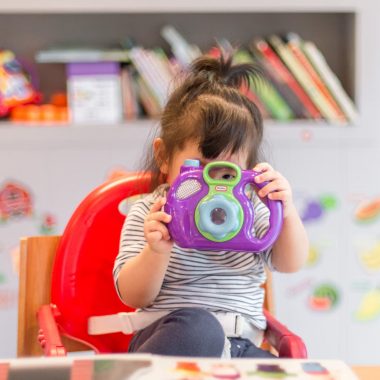Being the parent of a child with an intellectual and/or developmental disability (IDD) can be overwhelming. Aside from parenting on its own being a journey that requires strength, resilience and plenty of powering through, having a child diagnosed with IDD can increase the pressure on you. However, it’s completely normal to feel a bit overwhelmed.
A question many parents of children with IDD find themselves asking is “What do I do next?” What is the best way to support your child’s growth? While there are plenty of options to choose from, it can be a bit overwhelming to filter through them all and make a choice. There are numerous therapies designed to help children with IDD thrive—it’s all about finding the right fit.
In this post, we’ll dive into the top five therapy options that can make a real difference in your child’s life, helping them build essential skills, gain independence, and improve their quality of life. Whether your little one struggles with communication, motor skills, or social interaction, there’s a therapy out there that can meet their unique needs.
So, let’s take the guesswork out of the equation and explore the top therapies that many parents of children with IDD swear by.
Why Is Therapy Important for Children with IDD?
Therapy isn’t just about helping children with intellectual and developmental disabilities manage their day-to-day challenges—it’s about giving them the tools to truly flourish. Each child with IDD is unique, and therapy can play a key role in unlocking their full potential, both socially and developmentally.
Early intervention through therapy can improve motor skills, communication abilities, social interactions, and even emotional well-being. It provides a structured and supportive environment where children can develop important life skills at their own pace, which sets the foundation for future learning and independence.
According to the CDC, children who receive therapy before the age of 5 show more significant improvements in language and communication skills compared to those who start later. Plus, therapy doesn’t just benefit the child—it also helps families. It gives parents a clearer understanding of their child’s needs and how to best support their growth. It’s all about empowering the child and the family to lead more fulfilling lives together.
ALSO READ: 7 Myths and Facts About Autism Every Parent Must Know
1. Speech and Language Therapy (SLT)
Speech and Language Therapy (SLT) is one of the most effective interventions for children with intellectual and developmental disabilities (IDD) who face challenges with communication. For children with IDD, developing strong communication skills is crucial, as it affects their ability to express their needs, form relationships, and participate in everyday activities.
Speech therapy is not just about words; it’s about giving children the ability to connect with the world around them in meaningful ways.
This form of therapy focuses on improving a child’s ability to understand and use language. It helps children build vocabulary, form sentences, and develop the confidence to communicate their thoughts and feelings.
Beyond verbal skills, SLT can also work on non-verbal communication methods, such as gestures, facial expressions, and even assistive technologies like picture boards or speech-generating devices.
For children with IDD, speech therapy can also address difficulties with swallowing (a condition known as dysphagia), which is common in some forms of developmental disabilities. The therapy aims to improve overall communication—both verbal and non-verbal—allowing the child to better navigate social interactions.
Who Is Speech Therapy Ideal For?
Speech and Language Therapy is particularly beneficial for children with IDD who struggle with expressive or receptive language. It is often recommended for children with conditions such as:
- Autism Spectrum Disorder (ASD)
- Down Syndrome
- Cerebral Palsy
- Apraxia of Speech
- Intellectual Disabilities
ALSO READ: Understanding the IDD Spectrum: What Parents Need To Know
2. Occupational Therapy (OT)
Another popular form of therapy for children with intellectual and developmental disorders is occupational therapy (OT). It is a vital intervention technique designed to help children develop the necessary skills to perform daily activities independently. Unlike its name might suggest, OT isn’t about jobs or employment for children. Instead, it focuses on improving fine motor skills, sensory integration, coordination, and even cognitive development to promote independence in everyday life.
For children with IDD, even simple tasks like dressing, eating, or holding a pencil can be challenging. Occupational Therapy breaks down these tasks and teaches children how to accomplish them in manageable steps, making life’s daily activities more accessible and enjoyable.
The therapy often begins with an assessment, during which the therapist observes the child’s abilities and challenges in completing day-to-day activities. From there, a personalized plan is designed that may focus on areas such as improving hand-eye coordination, balance, or self-care skills.
OT can also address sensory processing disorders, which occur when the brain has difficulty receiving and responding to information from the senses. This often includes being overly sensitive to textures, sounds, or lights, or not being sensitive enough. Occupational therapists work with children to regulate these responses, helping them better interact with their surroundings.
Who Is Occupational Therapy Ideal For?
Occupational Therapy is highly recommended for children with IDD who struggle with everyday tasks and face challenges related to sensory processing or motor development. It is particularly beneficial for children diagnosed with:
- Autism Spectrum Disorder (ASD)
- Down Syndrome
- Attention-Deficit/Hyperactivity Disorder (ADHD)
- Cerebral Palsy
- Dyspraxia
- Sensory Processing Disorder (SPD)
Children who have difficulty coordinating movements or completing fine motor tasks, such as writing, cutting, or dressing, can benefit greatly from OT.
ALSO READ: Essential Tips for Parenting Children with Medical Complexities
3. Applied Behavior Analysis (ABA) Therapy
Applied Behavior Analysis (ABA) Therapy is a widely used, evidence-based approach that focuses on improving specific behaviors such as communication, social skills, and adaptive learning in children with intellectual and developmental disabilities (IDD). ABA is rooted in the principles of behaviorism, which suggests that behavior can be shaped and changed through reinforcement.
It is particularly effective for children with Autism Spectrum Disorder (ASD), but its benefits extend to a range of other developmental disabilities. By breaking down complex tasks into smaller, manageable steps and reinforcing positive behaviors, ABA therapists help children acquire the skills they need to function independently in everyday life.
The U.S. Surgeon General and the American Psychological Association endorse ABA as a scientifically backed approach to behavioral therapy. This form of therapy works by closely analyzing a child’s behavior and environment to understand why certain behaviors occur. Based on this analysis, therapists create a tailored plan to encourage positive behaviors and reduce or eliminate challenging ones.
For example, if a child struggles with aggressive outbursts, an ABA therapist will observe what triggers the behavior and what consequences follow. Then they will design interventions to teach the child more appropriate ways to communicate their needs, while reinforcing positive behaviors through rewards like praise or preferred activities.
Who is ABA Therapy Ideal For?
ABA therapy is most commonly associated with Autism Spectrum Disorder (ASD), but it is equally beneficial for children with a wide range of developmental disabilities. ABA is ideal for children who:
- Display repetitive or problematic behaviors
- Struggle with social interactions
- Experience delays in communication or adaptive learning
- Have difficulty with transitions or changes in routine
This therapy can be delivered in different settings, such as at home, in school, or in a clinic, and the approach can be one-on-one or in a group setting, depending on the child’s needs.
ALSO READ: How To Spot Medical Complexities In Children?
4. Physical Therapy (PT)
For children who face challenges with mobility, coordination, balance, and motor skills, Physical Therapy (PT) is an essential intervention technique. It aims to improve the child’s ability to perform physical activities, enhance muscle strength, and boost overall physical independence.
According to research published in the Journal of Pediatric Physical Therapy, early intervention with physical therapy can significantly improve motor function in children with cerebral palsy and other developmental disabilities. By focusing on movement and physical function, PT can significantly improve the child’s quality of life, making everyday tasks easier and more enjoyable.
While physical therapy is often thought of as being primarily for orthopedic or physical injuries, it plays a crucial role in helping children with developmental challenges gain functional abilities, such as walking, sitting, or even grasping objects. These improvements not only benefit the child’s physical development but also support their cognitive and social progress by fostering greater independence and participation in daily activities.
This form of therapy often focuses on helping children with intellectual and developmental disabilities gain motor skills that may be delayed or difficult to achieve, such as crawling, walking, standing, or climbing stairs. Through carefully designed exercises and activities, physical therapists work to improve the child’s gross motor skills and overall mobility.
Additionally, PT may help prevent secondary conditions, such as muscle contractures or joint deformities, by maintaining and improving flexibility.
Who is Physical Therapy Ideal For?
Physical therapy is beneficial for children with a wide range of developmental disabilities, including but not limited to:
- Cerebral palsy
- Down syndrome
- Muscular dystrophy
- Spina bifida
- Global developmental delays
Physical Therapy can be started as early as infancy and continued through childhood as the child grows and develops.
ALSO READ: Does My Baby Have Autism? – Signs & Early Intervention Methods
5. Music Therapy
While seemingly controversial, Music Therapy uses music as a therapeutic tool to promote communication, social skills, and emotional expression while stimulating cognitive and physical development. Music Therapy harnesses the power of music to address the physical, emotional, cognitive, and social needs of children with intellectual and developmental disabilities (IDD).
Music is an inherently motivating and engaging medium that can connect with children in ways other forms of therapy cannot. Whether it’s playing an instrument, singing, or moving to a rhythm, these activities stimulate multiple areas of the brain, leading to significant developmental benefits. Research published in Autism Research and Treatment found that children with autism who participated in music therapy showed significant improvements in social responsiveness and emotional regulation.
Music therapists are trained professionals who assess a child’s unique needs and goals, using structured musical interventions to enhance specific developmental areas such as language, motor skills, and emotional regulation. From babies to older children, music therapy is adaptable and can be customized to meet the child’s preferences, making it a highly enjoyable and beneficial experience.
Music therapy encourages children with IDD to engage with sound, rhythm, and movement in a therapeutic setting. Music therapists use a variety of techniques, including:
- Singing: Encourages communication and speech development.
- Playing instruments: Enhances fine motor skills, hand-eye coordination, and sensory integration.
- Dancing or moving to music: Develops gross motor skills and helps with coordination.
- Songwriting: Promotes self-expression, allowing children to express emotions and ideas.
Who is Music Therapy Ideal For?
Music therapy is particularly beneficial for children with a wide range of developmental disabilities, such as:
- Autism Spectrum Disorder (ASD)
- Cerebral Palsy
- Down Syndrome
- Speech and language delays
ALSO READ: Early Signs of Intellectual and Developmental Disabilities in Babies
Finding the right therapeutic interventions is crucial for helping children with intellectual and developmental disabilities reach their full potential. From Speech and Language Therapy to Music Therapy, each approach offers unique benefits that can address specific challenges and foster development in critical areas.
While each child is different, combining multiple therapies can offer more comprehensive methods of support. Therapy is more than just a clinical process—it’s a way to unlock each child’s abilities, build their confidence, and improve their overall well-being.
By working closely with a team of therapists, families can create a personalized treatment plan that empowers their child to grow, learn, and thrive. Ultimately, the key is early intervention, consistency, and a therapy program tailored to meet each child’s unique needs.










